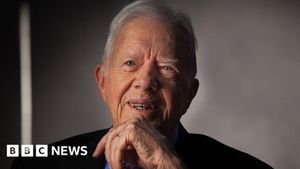Chemnitz is celebrating significant cultural milestones as the Museum for Saxon Vehicles marks its 30th anniversary, showcasing the city's rich automotive heritage, and local football fans gear up for their largest derby turnout this season, portraying the vibrant spirit of the community.
On the evening of January 31, 2025, the museum held a retrospective event featuring its founder, Frieder Bach. With great enthusiasm, Bach, described as the ‘father of the museum,’ extended his passion for vintage vehicles during an engaging presentation. Originally opened at Wasserschloss Klaffenbach, the museum now resides at Zwickauer Straße 77, where it has adapted and grown since its beginnings. Attendees were treated to stories about the museum's significant milestones, which started over three decades ago, reveling not just the vehicles on display but the passionate community behind them.
Tragically, the event coincided with the news of the passing of Jörgen Skafte Rasmussen, grandson of DKW's founder. Bach expressed deep sadness, stating, "Damit ist der Letzte von uns gegangen, von dem man noch Informationen und Unterlagen zum Thema DKW aus erster Hand hätte bekommen können." This loss emphasizes the generational ties to the history of automotive innovation within the region.
The evening’s program extended beyond nostalgia, focusing on the vision to educate new generations about the importance of local history through intimate gatherings and thoughtful discussions. More than 60 eager participants filled the space, leading to the announcement of another similar event scheduled for March 20, 2025, owing to overwhelming interest.
Meanwhile, on Sunday, February 1, 2025, the Chemnitzer FC is all set to witness the largest away fan attendance this season as over 1,700 supporters travel to Zwickau for the district derby against FSV Zwickau. Fans began laying plans for this derby weeks ago, showcasing solidarity and pride for their team as they aim for victory on the pitch.
The rivalry has historical roots; both teams hail from the former district of Karl-Marx-Stadt. Formerly, these clubs fought fiercely for local pride during the DDR era, and today, the spirit remains unchanged. Local fan groups have made this derby something to look forward to, fostering friendships and rivalries among neighboring fanbases. Interestingly, the Chemnitz FC's previous notable trip saw around 1,000 fans supporting their team, making this derby outing even more significant.
Fans arriving at Zwickau can expect to join over 7,300 spectators anticipated at this highly competitive game. With the momentum of victory and camaraderie surrounding the local team, this derby promises to be more than just another game; it’s about pride and identity for the community.
The sense of community continues to be reaffirmed through art. Artists Stefan Schleupner and Markus Stein, currently engaged with the Hallenkunst project, introduce innovative electronic fabrics displayed at the Cammann-Haus. This blend of technology and creativity offers visitors glimpses of vibrant artworks, redefining interactions within Chemnitz’s art scene.
Such endeavors are additional layers to the city’s cultural narrative, instilling hope and confidence among residents and inspiring upcoming creatives. The Hallenkunst initiative stands as part of embracing advancements, bringing the community together through artistic expression.
Adding to this literary scene, local author Heike Meisegeier has also launched her new historical novel titled “Blutsbande.Blutschande,” exploring themes of love against the backdrop of German history. Her works resonate deeply with residents, capturing the sentiments surrounding the divide and reunification experiences throughout the country's history.
Through various events, from fan gatherings to artistic expressions and literary discussions, Chemnitz appears to be on the cusp of cultural rebirth. Each occasion serves to strengthen community bonds, encourage participation, and open new channels for dialogue, making it apparent: Chemnitz is transforming.
Despite its troubled past, the diverse narratives being shared today position Chemnitz uniquely within the larger cultural discourse of Germany, signaling bright days ahead. Ulrike Lynn encapsulated this sentiment well, expressing, "Chemnitz ist eine Stadt voller Brüche und Risse - eine verwundete Stadt. Eine Stadt, die sich nach Heilung sehnt, nach Versöhnung, nach Selbstvertrauen und Wertschätzung." Through healing and acceptance, the collective ambition to redefine Chemnitz’s narrative continues to grow stronger.



